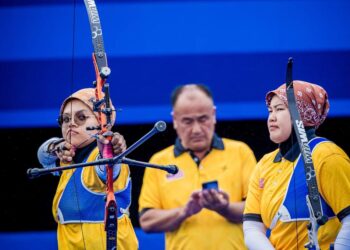One of the biggest challenges new archers face is shooting in windy conditions. My first Texas Shootout – one of USA Archery’s USAT Qualifer Series tournaments, and my second outdoor tournament – was one of the windiest competitions I’ve ever shot. Having just bought a set of very expensive new tournament arrows, I was terrified of missing the target bail and losing my arrows.
As it turns out, I did miss my bail – about eight of my arrows hit the target next to mine. However, misses happen, they are part of archery and nothing to be afraid of. Since then, I’ve grown to love shooting in the wind. How did I go from panic to confidence in windy conditions? Here are my top six tips:
TRUST YOUR SHOT & BE AGGRESSIVE
My No. 1 tip for shooting in the wind is to be confident. When it gets windy, don’t panic and question everything. Remember the fundamentals of your shot – the process you use for shooting. Pick a spot to aim, and then trust it. This advice is as valid for beginners as it is for expert archers. Archers shooting in the wind must trust their judgment about wind strength.
Trust lets you shoot a strong shot, which benefits you in two ways. First, even if the wind pushes the arrow, it will be less affected if you release a good, strong shot vs. a weak, tentative shot. Second, you will receive accurate feedback, which lets you make adjustments. If you make a strong shot and it scores a left 9, you know you must account for the wind pushing your arrow left. If, however, you make a weak shot, you’ll question whether your arrow hit left because of you or the wind. You won’t know where to aim your next arrow.
USE WHAT YOU HAVE AVAILABLE
The good news: there’s help for judging wind at target archery tournaments: small flags that are placed atop each target bail, and wind “socks,” hollow fabric tubes that move in the direction the wind is blowing.
The bad news: field setups aren’t mandated to always place enough wind socks in proper locations to help archers gauge the wind. The little flags on each target can be deceiving, and don’t always help determine wind strength. What can you do? First, use the flags for determining direction. Pay attention to other things on or near the field – such as trees, banners, or state flags – for indicators of wind strength. Also, watch your opponents’ arrows. A quick look at nearby targets reveals where they’re hitting. In addition, use all the time you’re given to shoot. Wait for strong gusts to pass before shooting. Take a couple of extra seconds to watch the wind flags, and try to time your shots as best as you can to avoid gusts.
STRENGTHEN YOUR CORE
Plank exercises, like this elbow plank, are a great way to strengthen your core. Photo credit: Pop Sugar Fitness
To shoot strong, aggressive shots in windy conditions, you need a strong core, which gives you a steadier shooting base that’s less affected by wind. You’ll find many options for building core strength, but archery-specific training tools like the Flexor System are a good bet. For those who don’t want to buy an exercise system, body weight exercises like planks, pushups, sit-ups, etc., will suffice. You can do them almost anywhere, and with no equipment. To increase motivation, join the #plankaday challenge on Twitter.
SHOULD YOU MOVE YOUR SIGHT, TILT YOUR BOW OR AIM OFF?
Olympic champion Ki Bo Bae of Korea moves her sight at the recent, very windy World Archery Championships. Photo credit: World Archery
Talk to 10 of the world’s top shooters, and you’ll get 10 different answers on whether they move their sights, cant (tilt) their bows, or aim off for the wind. Each of these tricks refers to methods for compensating for wind. In other words, if the wind is blowing from left to right and pushing your arrows to the right scoring rings on the target, these methods help you to compensate for that left to right movement. Learn what works for you.
Generally, moving your sight only works if the wind is relatively calm, steady and moving in a single direction. Archers tend to use this option only when the wind is very predictable. This also requires continued attention to your sight, in case the wind dies off or changes direction. For example, if your arrows are hitting too far to the right, you can try moving your sight to the right – “following the miss” – to compensate for the wind. But again, this method will only help in a steady breeze.
Both compound and recurve archers can try what’s called “canting” their bows – in other words, tilting the bow. To cant the bow, recurve archers tip their top limb into the wind. Compound archers do what’s called “bubbling off,” as compound shooters use a sight with a liquid level in the middle that helps them keep the bow straight. By canting the bow, compound archers move the bubble in the sight level, which shows them how far off center they are leaning.
For recurve archers, the primary disadvantage to this method is that it can be a little imprecise, while compound archers can use the bubble in their level as a reference for how far they are canting the bow. The major advantage to canting the bow or bubbling off is that you can still aim at the middle of your target, but you’ll want to pay close attention to how much you’re canting or bubbling off each time.
One of the most frequently used tricks for dealing with wind is “aiming off” – in other words, aiming to the left or right (or high or low) of the spot that you actually want to hit, to compensate for the wind. For example, let’s say that the wind is blowing left to right. To aim off, you could aim left of center, knowing that the wind will carry your arrows further right, hopefully hitting the middle of your target. This method lets you aim very precisely each time, but the trick is to follow through by continuing to aim off, not drifting back to the center of your target at the last second.
PRACTICE, PRACTICE, PRACTICE
What are those flags telling you? Learning how to read the flag on top of your target can tell you a great deal about wind conditions – and what to do about them.
The only way to get better at shooting in the wind is to practice in the wind. Should you practice during a hurricane? No, but learning how you and your arrows handle wind can only be discovered through trial and error. Instead of avoiding tournaments that are often windy, seek out windy events and shoot them. If it’s always calm where you shoot, try to find a different location that’s windy. Get a small wind flag and put it on top of the target you practice on at home – and even consider buying a wind sock and putting one in your yard so that you get used to seeing it and “reading” it. The key is to practice in wind so you can keep your form consistent regardless of environmental conditions.
STAY MENTALLY STRONG
As an archer, you will shoot in varied weather conditions. How you prepare for them will help determine your scores. Photo credit: World Archery
Wind can give you an advantage! How? Don’t show up thinking: “Oh boy, its windy out here. This could be bad.” Instead, go in thinking: “It’s windy out there! I shoot well in the wind, and this will be fun!” Be optimistic and accept the challenge. Plus, the wind is the same for all competitors on the field – even the most experienced veterans are going to be affected by the wind. Shooting a windy tournament requires 100 percent focus and concentration until the last arrow flies. If you have a bad end, shake it off and move onto the next shot. Your attitude can be your biggest advantage over your competition!

























